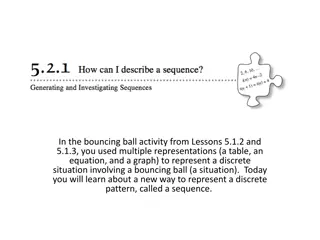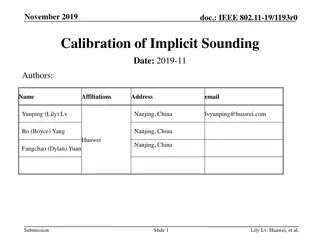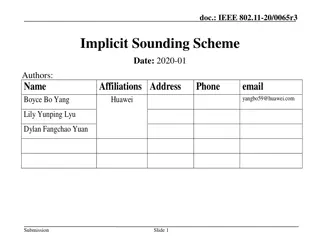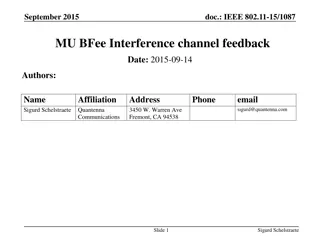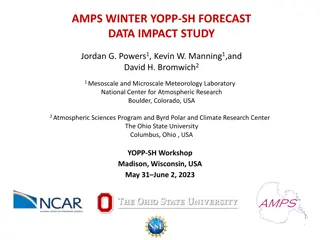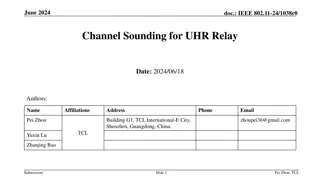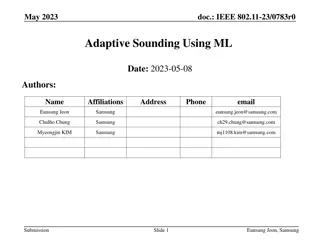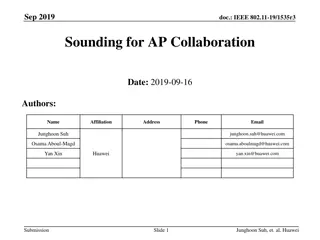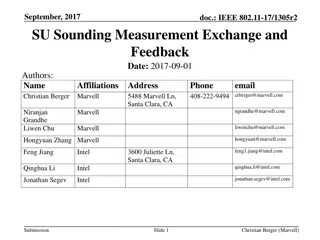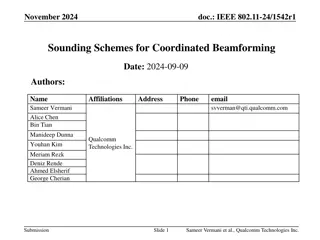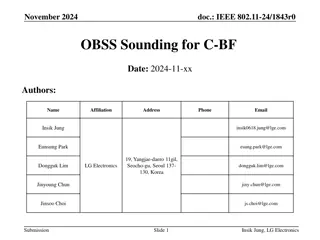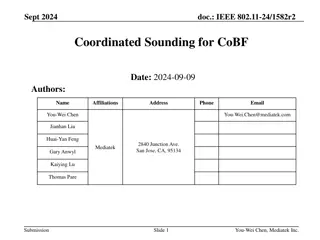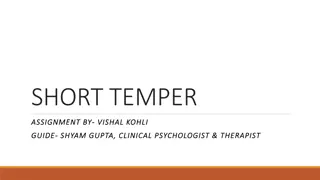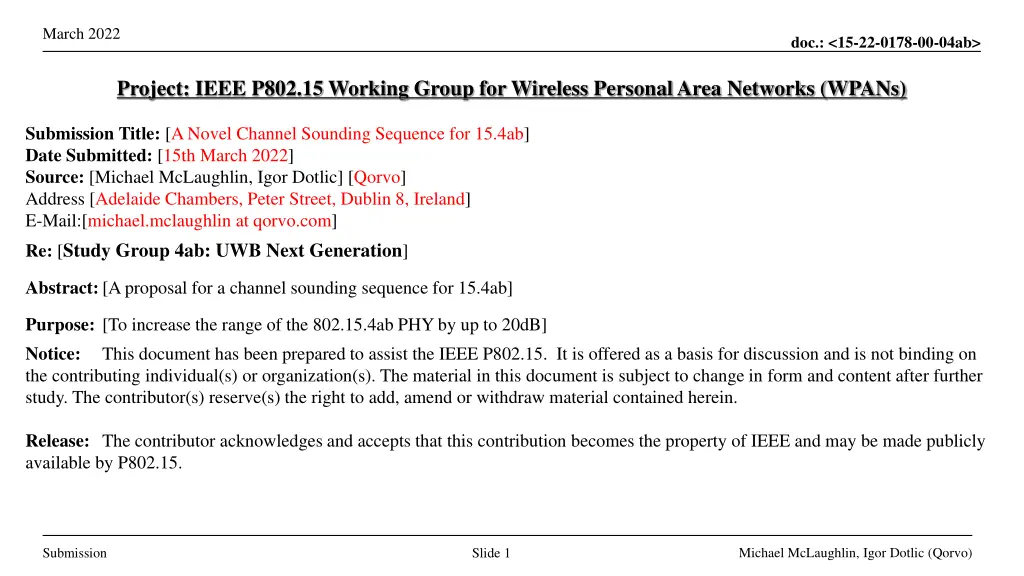
Innovative Channel Sounding Sequence for 802.15.4ab WPANs
Enhance your understanding of the proposed channel sounding sequence for IEEE P802.15 WPANs with this detailed submission by Michael McLaughlin and Igor Dotlic from Qorvo. The document outlines a novel solution aimed at increasing the range of the 802.15.4ab PHY by up to 20dB, focusing on interference mitigation, coexistence improvement, link budget enhancement, and more. Dive into the technical guidance, objectives, and safeguards provided in this submission.
Download Presentation

Please find below an Image/Link to download the presentation.
The content on the website is provided AS IS for your information and personal use only. It may not be sold, licensed, or shared on other websites without obtaining consent from the author. If you encounter any issues during the download, it is possible that the publisher has removed the file from their server.
You are allowed to download the files provided on this website for personal or commercial use, subject to the condition that they are used lawfully. All files are the property of their respective owners.
The content on the website is provided AS IS for your information and personal use only. It may not be sold, licensed, or shared on other websites without obtaining consent from the author.
E N D
Presentation Transcript
March 2022 doc.: <15-22-0178-00-04ab> Project: IEEE P802.15 Working Group for Wireless Personal Area Networks (WPANs) Submission Title: [A Novel Channel Sounding Sequence for 15.4ab] Date Submitted: [15th March 2022] Source: [Michael McLaughlin, Igor Dotlic] [Qorvo] Address [Adelaide Chambers, Peter Street, Dublin 8, Ireland] E-Mail:[michael.mclaughlin at qorvo.com] Re: [Study Group 4ab: UWB Next Generation] Abstract: [A proposal for a channel sounding sequence for 15.4ab] Purpose: [To increase the range of the 802.15.4ab PHY by up to 20dB] Notice: This document has been prepared to assist the IEEE P802.15. It is offered as a basis for discussion and is not binding on the contributing individual(s) or organization(s). The material in this document is subject to change in form and content after further study. The contributor(s) reserve(s) the right to add, amend or withdraw material contained herein. Release: The contributor acknowledges and accepts that this contribution becomes the property of IEEE and may be made publicly available by P802.15. Michael McLaughlin, Igor Dotlic (Qorvo) Submission Slide 1
March 2022 doc.: <15-22-0178-00-04ab> Technical Guidance PAR Objective Proposed Solution (how addressed) Safeguards so that the high throughput data use cases will not cause significant disruption to low duty-cycle ranging use cases. Interference mitigation techniques to support higher density and higher traffic use cases This proposal reduces airtime by a factor of 16 or more thus reducing the probability of collisions by the same factor. In contrast to, for example, m-sequences, Ipatov sequences, there are, literally, millions of CZC sequences of length 64. This means that many different logical channels can be supported Other coexistence improvement Backward compatibility with enhanced ranging capable devices (ERDEVs). Improved link budget and/or reduced air-time This proposal reduces airtime by a factor of 16 or more and improves link budget by up to 20dB Additional channels and operating frequencies Improvements to accuracy / precision / reliability and interoperability for high-integrity ranging; Reduce complexity and power consumption; This proposal reduces airtime by a factor of 16 or more and in that way reduces transmitter and receiver power consumption by approximately the same factor Hybrid operation with narrowband signaling to assist UWB; This proposal removes the need for narrowband assistance Enhanced native discovery and connection setup mechanisms; This sequence, by virtue of its extremely short duration, enables a wake-up radio with a similar link budget to current 802.15.4z devices The lower PRF proposed here enhances sensing operation Sensing capabilities to support presence detection and environment mapping; Low-power low-latency streaming higher data-rate streaming allowing at least 50 Mbit/s of throughput. Support for peer-to-peer, peer-to-multi-peer, and station-to-infrastructure protocols; In contrast to, for example, m-sequences, Ipatov sequences, there are, literally, millions of CZC sequences of length 64. This means that many different logical channels can be supported This sequence, by virtue of its extremely short duration, enhances synchronisation mechanisms Infrastructure synchronization mechanisms. Michael McLaughlin, Igor Dotlic (Qorvo) Submission Slide 2
March 2022 doc.: <15-22-0178-00-04ab> A Novel Channel Sounding Sequence This contribution proposes a Channel Sounding Sequence that allows a UWB transceiver to do ranging with a link margin of at least 110dB Michael McLaughlin, Igor Dotlic (Qorvo) Submission Slide 3
March 2022 doc.: <15-22-0178-00-04ab> Seemingly unresolvable conflict Channel sounding sequences have two conflicting requirements Requirement 1 A repeating sequence has spectral lines at the repetition frequency with nulls in between UWB spectrum must have no nulls when measured with a 1MHz RBW => Sequence must be > than 0.5 s long, preferably 1 s long Requirement 2 A 40ppm CFO at 8GHz is 320kHz offset Over 1 s the phase drifts by ~120 The CIR estimate from 3 symbols accumulated will completely cancel each other out To get a channel estimate, many symbols need to be accumulated => Symbols need to be MUCH shorter than 1 s = Michael McLaughlin, Igor Dotlic (Qorvo) Submission Slide 4
March 2022 doc.: <15-22-0178-00-04ab> Enter CZC codes History of some useful channel sounding sequences Golay introduced Complementary Pairs in 1961. These are pairs of sequences the sum of whose autocorrelation sidelobes are zero. Complementary Sets were introduced in 1972 by Tseng and Liu. These are sets of sequences the sum of whose autocorrelation sidelobes are zero. Ipatov introduced ternary codes in 1980 which have perfect periodic auto- correlation. Igor Dotlic (Qorvo) took these Complementary Sets and added the property whereby neighbouring codes in a set have zero-sum cross correlation. We call these Complementary Zero-sum Cross-correlation Code Blocks or CZC codes This allows codes to be sent consecutively, with no gap, and they don t interfere with each other Michael McLaughlin, Igor Dotlic (Qorvo) Submission Slide 5
March 2022 doc.: <15-22-0178-00-04ab> Channel Sounding What we would like to do (But we can t) Infinitely Tall I Received signal Channel (i.e. CIR) . . . Where (Ix t)is some finite charge Infinitely Narrow t 0 T0 Michael McLaughlin, Igor Dotlic (Qorvo) Submission Slide 6
March 2022 doc.: <15-22-0178-00-04ab> Channel Sounding Next best thing (But we are not allowed) Very Tall I lots of mA Received signal Channel (i.e. CIR) . . . Very Narrow t < 1ps T0 Michael McLaughlin, Igor Dotlic (Qorvo) Submission Slide 7
March 2022 doc.: <15-22-0178-00-04ab> Channel Sounding A perfect solution? Correlated signal is CIR estimate Quite Narrow t ~ 2ns Channel (i.e. CIR) Not too tall, modest I T0 Michael McLaughlin, Igor Dotlic (Qorvo) Submission Slide 8
March 2022 doc.: <15-22-0178-00-04ab> Channel Sounding A perfect solution? Correlated signal is CIR estimate Quite Narrow t ~ 2ns Channel (i.e. CIR) Not too tall I ~ modest T0 Michael McLaughlin, Igor Dotlic (Qorvo) Submission Slide 9
March 2022 doc.: <15-22-0178-00-04ab> Channel Sounding We can analyse this more easily like this A sequence with perfect Autocorrelation Channel (i.e. CIR) Correlated signal is CIR estimate Quite Narrow t ~ 2ns T0 Not too tall I ~ modest T0 Michael McLaughlin, Igor Dotlic (Qorvo) Submission Slide 10
March 2022 doc.: <15-22-0178-00-04ab> Channel Sounding A perfect solution? A sequence with perfect Autocorrelation Channel (i.e. CIR) Correlated signal Quite Narrow t ~ 2ns T0 Not too tall I ~ modest T0 Michael McLaughlin, Igor Dotlic (Qorvo) Submission Slide 11
March 2022 doc.: <15-22-0178-00-04ab> Channel Sounding: Golay Pairs 1st of a pair with perfect Autocorrelation sum 2nd of a pair with perfect Autocorrelation sum Quite Narrow t ~ 2ns Quite Narrow t ~ 2ns Not too tall I ~ modest + = Michael McLaughlin, Igor Dotlic (Qorvo) Submission Slide 12
March 2022 doc.: <15-22-0178-00-04ab> Channel Sounding: Ipatov Sequences Ipatov sequences have perfect periodic autocorrelation Michael McLaughlin, Igor Dotlic (Qorvo) Submission Slide 13
March 2022 doc.: <15-22-0178-00-04ab> Complementary Sets By adding together all the impulse responses a perfect CIR estimate is found -----+++ ++++-+++ -+-+++-+ +-+-++-+ -++----+ ++---+-- -++-+++- ++--+-++ Example 8 x 8 complementary set A drawback is that the codes need to be sent with a gap between them to allow the multipath for each code to die away Michael McLaughlin, Igor Dotlic (Qorvo) Submission Slide 14
March 2022 doc.: <15-22-0178-00-04ab> Complementary Zerosum Cross-correlation Blocks By adding together all the impulse responses a perfect CIR estimate is found even when the codes are sent directly following each other -----+++ ++++-+++ -+-+++-+ +-+-++-+ -++----+ ++---+-- -++-+++- ++--+-++ Example 8 x 8 CZC code block If the CZC block has this property, then provided the multipath has a delay of less than or equal to the code length, all the cross correlations will cancel each other out Michael McLaughlin, Igor Dotlic (Qorvo) Submission Slide 15
March 2022 doc.: <15-22-0178-00-04ab> CZC Blocks with Double Protection We can also ensure a zero sum of the cross correlations of the next nearest neighbour If the CZC block has this property, then provided the multipath has a delay of less than or equal to twice the code length, all the cross correlations will cancel each other out. Of course we can extend this concept to more neighbours if needed +++- +-++ ++-+ +--- +++- +-++ ++-+ +--- ---+ +-++ --+- +--- +++- -+-- ++-+ -+++ Example16 x 4 CZC code block with double cc protection Michael McLaughlin, Igor Dotlic (Qorvo) Submission Slide 16
March 2022 doc.: <15-22-0178-00-04ab> Why CZCs solve the length conflict problem: CZCs combine the virtues of both long and short codes An 16 x 4 CZC block sent at 64MHz PRF has 64 pulses so it is 1 s long => No spectral lines When the receiver correlates with the same set and adds the correlation results together there are no auto correlation or cross correlation sidelobes, so a perfect channel estimate is obtained for each and every 1 s block Each individual 4 pulse code only lasts 64ns so have negligible rotation, 7.5 Over the 16 codes whose correlations are summed, the worst case (40ppm) rotation averages to 60 This is a small enough rotation to get a good channel estimate which can give a good estimate of the rotation of the channel caused by the carrier offset. ----- -----+++ ++++ ++++- -+++ - -+ +- -+++ +++- -+ + + +- -+ +- -++ - -++ ++---- ----+ + ++ ++--- ---+ +-- - -++ ++- -+++ ++ ++-- --+ +- -++ +++ +++ ++- -+ + -- +++- - ++ Example 8 x 8 CZC code block +++ +++- - + +- -++ ++ ++- -+ + + +--- --- +++ +++- - + +- -++ ++ ++- -+ + + +--- --- --- ---+ + - -+ +-- ++ ++- -+ + + +--- --- +++ +++- - + +- -++ -- --+ +- - - -+++ +++ ++ ++ -- ++ Example 16 x 4 CZC code block Michael McLaughlin, Igor Dotlic (Qorvo) Submission Slide 17
March 2022 doc.: <15-22-0178-00-04ab> A new channel estimate is found every 64ns After the first 1 s 16 codes have been received This forms a perfect channel estimation block Each 64ns a new code is received which also forms a perfect block So, e.g., a 4 s block, 64 x 4 pulse symbols gives us 48 different CIR estimates Each with zero auto-correlation and cross-correlation sidelobes Michael McLaughlin, Igor Dotlic (Qorvo) Submission Slide 18
March 2022 doc.: <15-22-0178-00-04ab> Further Advantages of the short CZC sequence (1) A UWB signal with exactly one pulse every 16ns has the same peak power as mean power in 50MHz RBW. This allows 24dBs of gain to be applied and for the signal to be as short as 4 s which is 4 CZC code blocks sent consecutively This boosts the Link Margin by 24dB for the duration of the sequence Very low average Transmitter power consumption (6% duty cycle vs shortest 4z packet) Very low Receiver power consumption (6% of power required vs shortest 4z packet) After the position of the burst is determined, the receiver, in e.g. the tag, can be turned off for most of the 1ms containing the burst Michael McLaughlin, Igor Dotlic (Qorvo) Submission Slide 19
March 2022 doc.: <15-22-0178-00-04ab> Further Advantages of the short CZC sequence (2) Very low (0.4%) duty cycle makes collisions with other UWB packets very unlikely Correlator outputs can be stored in memory and processed serially during next 1ms to search for best CFO estimate, e.g. by finding optimum rotation. For transmitters with limited Tx gain capability, e.g. the tag, a much longer sequence can be transmitted, e.g. 32 s There are millions of CZC sequences of size 16 x 4 (I have found over 3,500,000 unique sequences in < 10-8 of search space) Michael McLaughlin, Igor Dotlic (Qorvo) Submission Slide 20
March 2022 doc.: <15-22-0178-00-04ab> 1ms Fragments:Qorvo View Initial TOA, CIR and CFO estimate Possible Data packet Further Refinement Possible Data packet Refined CIR, TOA UWB data fragM UWB CZC frag1 UWB CZC frag2 UWB CZC frag3 UWB data fragN . . . . . . . . . 2ms 1ms . . . Mms 3ms Nms Michael McLaughlin, Igor Dotlic (Qorvo) Submission Slide 21
March 2022 doc.: <15-22-0178-00-04ab> Performance at 107dB Link Margin Detection rate: 100% in each 1ms using 1 s (64 pulse) correlator The CFO here is estimated by doing a serial search for the best rotation Michael McLaughlin, Igor Dotlic (Qorvo) Submission Slide 22
March 2022 doc.: <15-22-0178-00-04ab> Performance at 110dB Link Margin Detection rate: 86% in each 1ms using 1 s (64 pulse) correlator The CFO here is estimated by doing a serial search for the best rotation Michael McLaughlin, Igor Dotlic (Qorvo) Submission Slide 23
March 2022 doc.: <15-22-0178-00-04ab> Performance at 112dB Link Margin Detection rate: Currently 25% in each 1ms using 1 s (64 pulse) correlator Michael McLaughlin, Igor Dotlic (Qorvo) Submission Slide 24
March 2022 doc.: <15-22-0178-00-04ab> Very long range ranging measurement Fixed response delay does not require data transfer At very high link margins, data transfer may be challenging. Unless multi-ms data fragments are used For this situation, a fixed response delay can be used E.g. say a tag is being searched for by someone with a phone. A fixed response delay can be used until the phone gets closer to the tag A unique CZC code could have been previously chosen to avoid collisions Extremely weak direct paths can be found with multi-ms fragments if a weak, but stronger, reflected path is present. Michael McLaughlin, Igor Dotlic (Qorvo) Submission Slide 25
March 2022 How accurately does the CFO need to be estimated? doc.: <15-22-0178-00-04ab> The better the accuracy, the less uncertainty there is in the TOA of the next burst 1ppm drift error over 1ms is a 1ns drift in time The 5ppm accuracy achieved here, with one fragment, at a link margin of 110dB allows the TOA of the next fragment to be predicted to within 5ns As the CFO accuracy is refined, even better fragment arrival time can be achieved Michael McLaughlin, Igor Dotlic (Qorvo) Submission Slide 26


